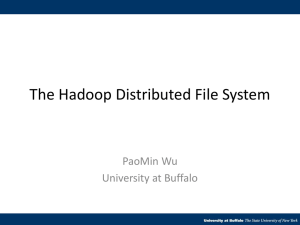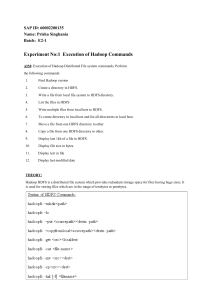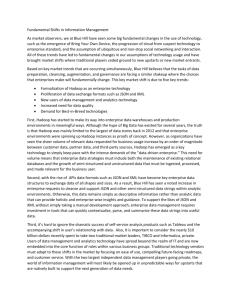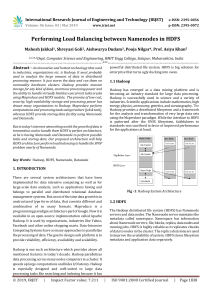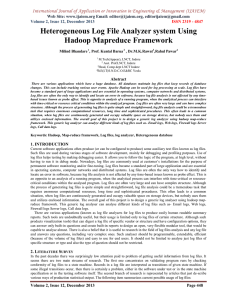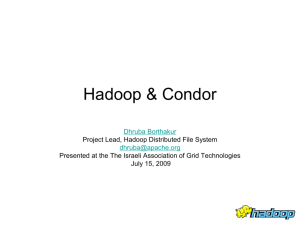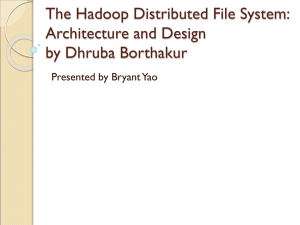M. Goenka - Center for Software Engineering
advertisement
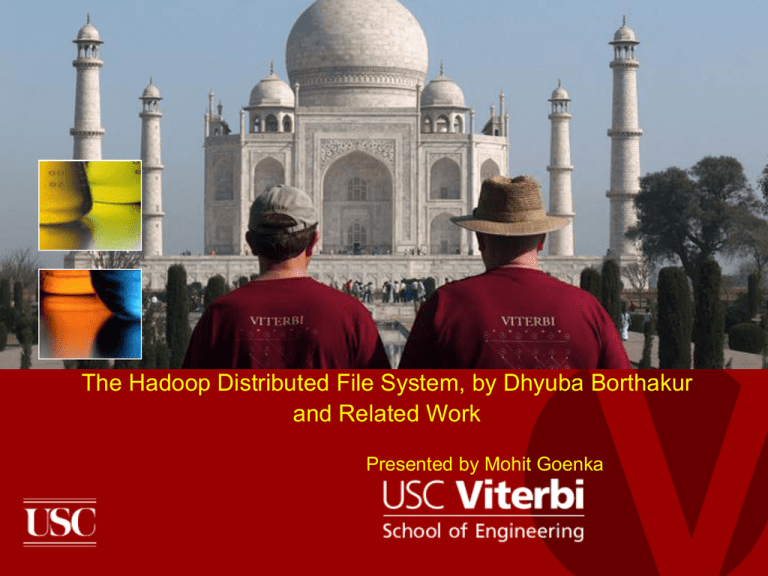
The Hadoop Distributed File System, by Dhyuba Borthakur and Related Work Presented by Mohit Goenka The Hadoop Distributed File System: Architecture and Design Requirement • Need to process Multi Petabyte Datasets SECTION TITLE • Expensive to build reliability in each application. • Nodes fail every day • Need common infrastructure Introduction • HDFS, Hadoop Distributed File System is designed to run on commodity hardware SECTION TITLE • Built out by brilliant engineers and contributors from Yahoo, and Facebook and Cloudera and other companies • Has grown into really large project at Apache with significant ecosystem Commodity Hardware SECTION TITLE • Typically in 2 level architecture – Nodes are commodity PCs – 30-40 nodes/rack – Uplink from rack is 3-4 gigabit – Rack-internal is 1 gigabit Goals • Very Large Distributed File System – 10K nodes, 100 million files, 10 PB • Assumes Commodity Hardware SECTION – Files are replicated to handle TITLE hardware failure – Detect failures and recovers from them • Optimized for Batch Processing – Data locations exposed so that computations can move to where data resides – Provides very high aggregate bandwidth • User Space, runs on heterogeneous OS HDFS Basic Architecture Cluster Membership NameNode Secondary NameNode SECTION TITLE Client Cluster Membership NameNode : Maps a file to a file-id and list of MapNodes DataNode : Maps a block-id to a physical location on disk SecondaryNameNode: Periodic merge of Transaction log DataNodes Distributed File System • Single Namespace for entire cluster • Data Coherency – Write-once-read-many access model TITLE – Client can only appendSECTION to existing files • Files are broken up into blocks – Typically 128 MB block size – Each block replicated on multiple DataNodes • Intelligent Client – Client can find location of blocks – Client accesses data directly from DataNode HDFS Core Architecture SECTION TITLE NameNode Metadata • Meta-data in Memory – The entire metadata is in main memory – No demand paging of meta-data SECTION TITLE • Types of Metadata – List of files – List of Blocks for each file – List of DataNodes for each block – File attributes, e.g creation time, replication factor • A Transaction Log – Records file creations, file deletions. etc Data Node • A Block Server – Stores data in the local file system (e.g. ext3) – Stores meta-data of a block (e.g.TITLE CRC) SECTION – Serves data and meta-data to Clients • Block Report – Periodically sends a report of all existing blocks to the NameNode • Facilitates Pipelining of Data – Forwards data to other specified DataNodes Block Placement • Current Strategy - One replica on local node - Second replica on a remote rack TITLE SECTION - Third replica on same remote rack - Additional replicas are randomly placed • Clients read from nearest replica • Would like to make this policy pluggable Data Correctness • Use Checksums to validate data – Use CRC32 • File Creation SECTION TITLE – Client computes checksum per 512 byte – DataNode stores the checksum • File access – Client retrieves the data and checksum from DataNode – If Validation fails, Client tries other replicas NameNode Failure • A single point of failure • Transaction Log stored in multiple directories SECTION TITLE - A directory on the local file system - A directory on a remote file system (NFS/CIFS) • Need to develop a real HA solution Data Pipelining • Client retrieves a list of DataNodes on which to place replicas of a block • Client writes blockSECTION to the first TITLE DataNode • The first DataNode forwards the data to the next DataNode in the Pipeline • When all replicas are written, the Client moves on to write the next block in file Rebalancer • Goal: % disk full on DataNodes should be similar – Usually run when new DataNodes are SECTION TITLE added – Cluster is online when Rebalancer is active – Rebalancer is throttled to avoid network congestion – Command line tool Hadoop Map / Reduce • The Map-Reduce programming model – Framework for distributed processing of large data sets – Pluggable user code runs in generic SECTION TITLE framework • Common design pattern in data processing cat * | grep | sort | unique -c | cat > file input | map | shuffle | reduce | output • Natural for: – Log processing – Web search indexing – Ad-hoc queries Data Flow Web Servers Scribe Servers SECTION TITLE Network Storage Oracle RAC Hadoop Cluster MySQL Basic Operations • Listing files - ./bin/hadoop fs –ls • Writing files SECTION TITLE - ./bin/hadoop fs –put • Running Map Reduce Jobs - mkdir input - cp conf/*.xml input - cat output/* Hadoop Ecosystem Projects • HBase - Big Table • HIVE SECTION TITLE - Built on Facebook, provides SQL interface • Chukwa - Log Processing • Pig - Scientific data analysis language • Zookeeper - Distributed Systems management Limitatons • The gigabytes to terabytes of data this system handles can only be scaled down to limited threshold SECTION TITLE • Due to this threshold being very high, the system is limited in a lot of ways • It hampers the efficiency of the system during large computations or parallel data exchange JSON Interface to Control HDFS An Open Source Project by Mohit Goenka JSON Interface to Control HDFS An Open Source Project by Mohit Goenka JSON • JSON (JavaScript Object Notation) is a lightweight data-interchange format TITLE • Can be easily read SECTION and written by humans • Can be easily parsed by machines • Written in text format • Similar conventions as existing programming languages JSON Data • It is based on two structures: - A collection of name/value pairs An ordered list of values SECTION TITLE • Concept: Use the light-weighted nature of JSON data to automate command execution on HDFS interface Goal • Designing a JSON interface to control HDFS SECTION TITLE • Development of two modules: - For writing into the system - For reading from the system Outcome • User can specify execution commands directly in the JSON file SECTION TITLE along with data • Only data gets stored into the system • Commands are deleted from the file after execution Sources and Acknowledgements Sources • Dhurba Borthakur, Apache Hadoop Developer, Facebook Data Infrastructure • Matei Zaharia, Cloudera / Facebook / UC Berkeley RAD Lab SECTION TITLE • Devaraj Das, Yahoo! Inc. Bangalore and Apache Software Foundation • HDFS Java API: - http://hadoop.apache.org/core/docs/current/api/ • HDFS source code: - http://hadoop.apache.org/core/version_control.html Acknowledgements • Professor Chris Mattmann for guidance as and when reqired SECTION TITLE • Hossein (Farshad) Tajalli for his continued support and help throughout the project • All my classmates for providing valuable inputs throughout the work, especially through their presentations That’s All Folks! SECTION TITLE

